| Gibside | |
|---|---|
Apr2006.jpg.webp) The shell of Gibside Hall | |
| Location | England |
| Nearest city | Newcastle upon Tyne |
| Coordinates | 54°55′28″N 1°43′36″W / 54.9245°N 1.7267°W |
| Built | 1603-1620 |
| Built for | Sir William Blakiston |
| Owner | National Trust |
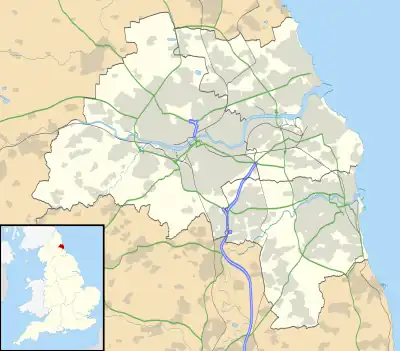 Location of Gibside in Tyne and Wear | |
Gibside is an estate in the Derwent Valley in North East England. It is between Rowlands Gill, in Tyne and Wear, and Burnopfield, in County Durham, and a few miles from Newcastle-upon-Tyne. Gibside was previously owned by the Bowes-Lyon family. It is now a National Trust property. Gibside Hall, the main house on the estate, is now a shell, although the property is most famous for its chapel. The stables, walled garden, Column to Liberty and Banqueting House are also intact.
History
The Blakiston family acquired the estate by marriage in about 1540. Sir William Blakiston (1562–1641) replaced the old house with a spacious mansion between 1603 and 1620. Both the Royal (King James I of England) coat of arms and the Blakiston coat of arms are seen over the entrance of the old Hall.[1] The Gibside property came into the possession of the Bowes family in 1713; a result of the marriage in 1693 of Sir William's great-granddaughter, Elizabeth Blakiston, to Sir William Bowes (1657–1707) of Streatlam Castle (now demolished).[2]
Until 1722,[3] the basis of the Bowes' influence was their own estate and house of Streatlam Castle, County Durham. However, after that date the acquisition through marriage of the Blakiston estate of Gibside gave the Bowes family an even greater influence in the north of the county and a share in the immense wealth that was to be acquired from the coal trade. The Blakiston estate included some of the area's richest coal seams.[4]
In 1767 the granddaughter of Sir William Bowes – the "Bowes heiress" Mary Eleanor Bowes – married John Lyon, 9th Earl of Strathmore and Kinghorne, who changed his surname to Bowes due to a provision in her father's will that any suitor had to take the family name. This was a device to continue the Bowes lineage in the absence of a male heir.[5]
After the split inheritance dispute following the death of John Bowes, 10th Earl of Strathmore and Kinghorne, in 1820, it belonged to his legitimated son John Bowes until his death in 1885 (he is buried in the Gibside chapel), when under the entail it reverted to his cousin the 13th Earl of Strathmore and Kinghorne. It had been the main residence of John Bowes' mother, Mary Milner, by then Dowager Countess of Strathmore, and her second husband, the politician Sir William Hutt (who had been John Bowes' tutor), and remained in his ownership until his death in 1882.[6]
18th-century additions

Improvements to Gibside carried out by the Bowes-Lyon family in the 18th and early 19th centuries included landscaping, Gibside Chapel, built between 1760 and 1812, the Banqueting House, a column of Liberty, a substantial stable block, an avenue of oaks and several hundred acres of forest. The top floor of the main house was remodelled as a giant parapet in 1805.[7]
The chapel reflects the Calvinist leanings of the family, and though nominally Anglican, the interior is dominated by a huge and centrally placed "three-decker" pulpit. There is a house for the minister/chaplain nearby. Some holders of the position would not have been able to hold a Church of England parish living, on account of their views. The leading Palladian architect James Paine is attributed with most of the work of the 1750s and 1760s.[8]
The Banqueting House was built in 1746, and is an early example of Gothic Revival architecture, of the early form often called "Gothick". It has now been restored and is available for letting by the Landmark Trust, who now own it.[9]
Column to British Liberty

A large monument, originally called the "Column of British Liberty", now usually just the "Column to Liberty", was begun in the 1750s by the hugely wealthy Sir George Bowes, reflecting his Whig politics. Set at the top of a steep hillock, the monument itself is a Doric order column, and topped by a standing bronze female figure, originally gilded, carrying a cap of liberty on a pole.[10]
Later history
The Bowes-Lyon family had other major country houses, Glamis Castle in Scotland, and Streatlam Castle, County Durham, relatively close to Gibside.[11]
The house became vacant in the 1920s after the Bowes-Lyon family sold some of its properties to pay death duties. The building was stripped of its fixtures and fittings, with many of the fireplaces and other items being transferred to Glamis Castle.[12] Parts of the structure were demolished in 1958, including the removal of the roof. What remains is protected by Grade II* listed building status[12] and included in the Heritage at Risk Register.[13]
Parts of the grounds have been designated a Site of Special Scientific Interest, including a forest garden.[14]
The chapel and Long Walk have been in the National Trust's ownership since 1965, and an additional 354 acres (1.43 km2) of the grounds were acquired in 1993. The Banqueting House has been in the ownership of the Landmark Trust since 1981, the building having been restored from a derelict shell. The stables now house a learning and discovery centre.[15]
Women's Land Army girls were billeted at Gibside during World War I.[12]
Gallery
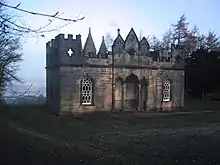
 Another view
Another view The Column to Liberty
The Column to Liberty.JPG.webp) The top of the column, the figure seen from behind.
The top of the column, the figure seen from behind.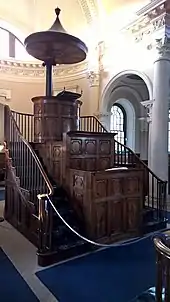 Centrally-placed three-decker pulpit at Gibside Chapel, a private chapel on the Calvinist edge of Anglicanism.
Centrally-placed three-decker pulpit at Gibside Chapel, a private chapel on the Calvinist edge of Anglicanism.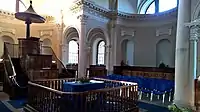 Interior of the Chapel
Interior of the Chapel The Column to Liberty can be seen from the porch of Gibside Chapel
The Column to Liberty can be seen from the porch of Gibside Chapel Shell of the Orangery
Shell of the Orangery The Stables
The Stables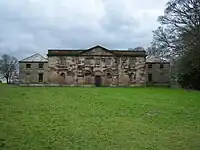 Side of the Stable block
Side of the Stable block
References
- ↑ "Photo c1932 - Royal (James I) Coat of Arms over Blakiston Coat of Arms. Gibside Hall". Durham County Council. 2009. Retrieved 12 November 2011.
- ↑ A Genealogical and Heraldic History of the Extinct and Dormant Baronetcies of England. Burke's Peerage. 1838. Retrieved 14 October 2012.
- ↑ Historic England. "Gibside Hall (22481)". Research records (formerly PastScape). Retrieved 26 October 2013.
- ↑ "Bowes and Strathmores – Gibside and Streatlam". Sunniside Local History Society. Retrieved 21 October 2012.
- ↑ Hughes, David (2007). The British Chronicles. Vol. 2. Heritage Books. p. 515. ISBN 978-0788444913.
- ↑ "Letter from William Hutt, Gibside Hall, Northumberland". Cambridge University. 22 January 1865. Retrieved 4 September 2022.
- ↑ "Gibside Hall". Heritage Gateway. Retrieved 4 September 2022.
- ↑ "Gibside Chapel". National Trust. Retrieved 4 September 2022.
- ↑ "Landmark Trust website: the Banqueting House". Archived from the original on 23 June 2011. Retrieved 20 May 2011.
- ↑ Green, Adrian, in Northern Landscapes: Representations and Realities of North-East England, 136-137, 2010, Boydell & Brewer, ISBN 184383541X, 9781843835417, google books; "Column to Liberty", National Trust.
- ↑ "Bowes and Strathmores – Gibside and Streatlam". Sunniside Local History Society. Retrieved 21 October 2012.
- 1 2 3 Historic England. "Gibside Hall, 17th to 19th century country house (1017224)". National Heritage List for England. Retrieved 4 April 2015.
- ↑ "Gibside Hall, B6314, Gibside Estate, Rowlands Gill, Whickham - Gateshead | Historic England". historicengland.org.uk.
- ↑ "Gibside: Conservation Area Character Statement" (PDF). p. 12.
- ↑ "Gibside National Trust - Historical attractions in Gateshead". NewcastleGateshead. Retrieved 4 August 2021.